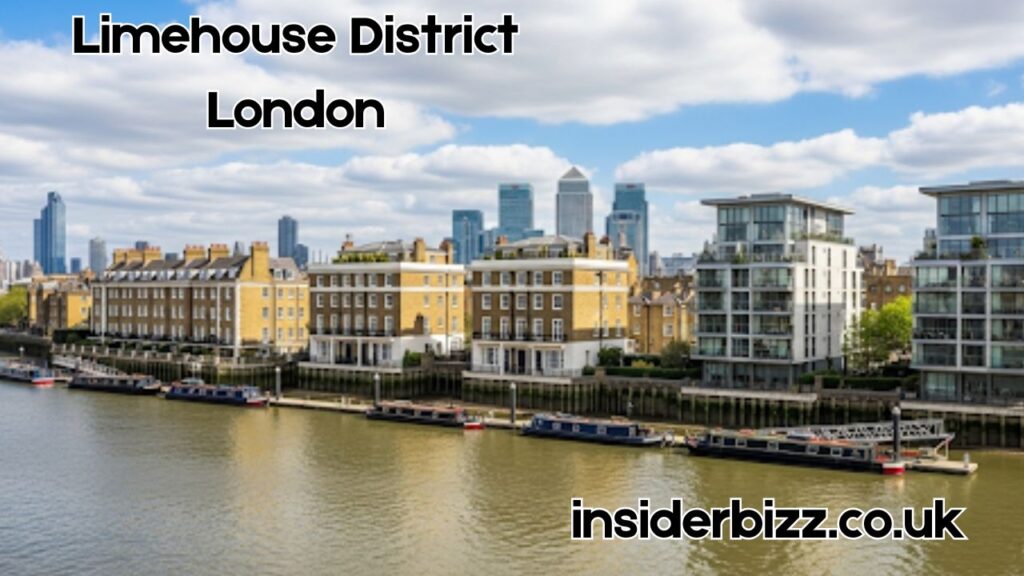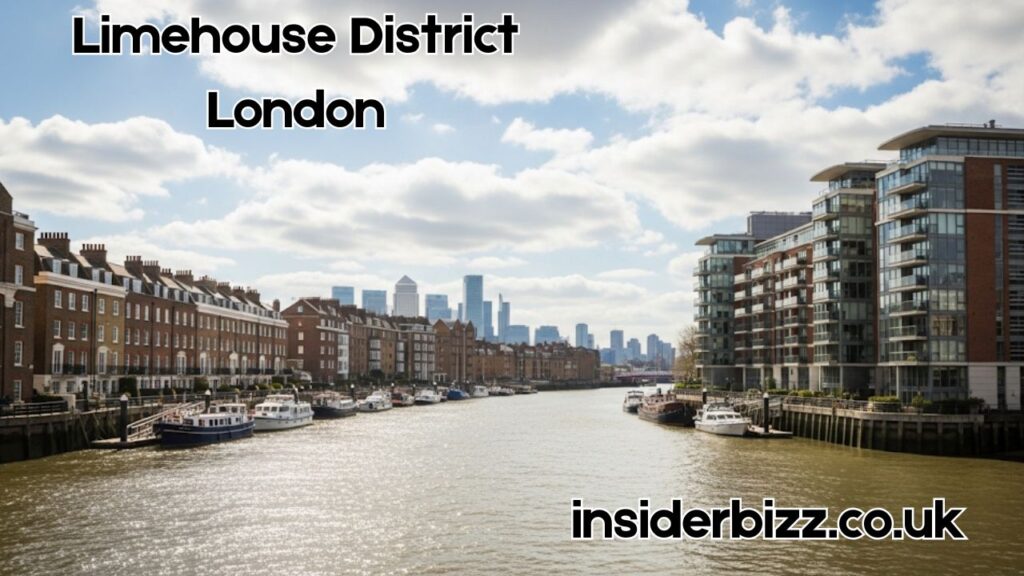
Limehouse District London: History, Culture, and Urban Revival
What Is Limehouse District London Known For?
Limehouse District London refers to a historic and culturally rich area located in the East End of London, along the north bank of the River Thames. Once a bustling hub for docks, sailors, and international trade, the Limehouse District London has evolved into a fascinating mix of old-world charm, urban redevelopment, and riverside living. It is known for its maritime legacy, unique architecture, and growing role in London’s modern landscape.
The Origins of Limehouse

The history of the Limehouse District London dates back to medieval times. The name “Limehouse” is believed to come from the lime kilns that once operated here to produce quicklime for construction. As London grew into a global port city, Limehouse became a major point for shipping, with bustling docks and warehouses. The district played a crucial role in Britain’s maritime trade, especially during the 18th and 19th centuries.
Limehouse and the River Thames
The Limehouse District London is inextricably linked to the River Thames. Its location made it an ideal point for shipping and shipbuilding. Limehouse Basin, originally called Regent’s Canal Dock, connected the Thames to London’s inland canal system. Today, it serves as a picturesque marina for houseboats and leisure vessels. The district’s waterfront remains a defining feature, offering stunning views and riverside walks.
Immigration and the First Chinese Community
In the 19th century, the Limehouse District London became home to Britain’s first Chinese community. Chinese sailors and traders settled in the area, establishing businesses such as laundries, tea shops, and small restaurants. This early Chinatown gave Limehouse an exotic reputation in Victorian literature, often exaggerated in fictional accounts. While the original Chinese community has since dispersed, the legacy of this cultural exchange still echoes through the district.
Literary Depictions and Urban Myth
The Limehouse District London has been portrayed in numerous books and stories, often with a sense of mystery and intrigue. Authors like Sax Rohmer, who created the fictional villain Dr. Fu Manchu, helped shape Limehouse’s image as a shadowy, exotic locale. While these depictions were often inaccurate and racially stereotyped, they left a lasting mark on the public imagination and contributed to Limehouse’s literary legacy.
Industrial Decline and Urban Decay
With the decline of London’s docks in the mid-20th century, the Limehouse District London faced economic hardship. Shipping routes changed, docks closed, and industrial activity slowed. The area fell into decline, marked by poverty, derelict buildings, and high unemployment. This period significantly shaped the district’s social fabric and reputation as a forgotten part of London.
Limehouse in the Age of Regeneration
Starting in the 1980s and accelerating through the 1990s, the Limehouse District London underwent major regeneration. Former warehouses and factories were converted into flats, luxury apartments, and commercial spaces. The Docklands Light Railway (DLR) improved transport links, making Limehouse more accessible. Today, the district is a mix of historic charm and modern development, with a growing appeal to young professionals and families.
Architectural Highlights in Limehouse
Limehouse District London boasts a range of architectural styles, from Georgian terraced houses to converted industrial warehouses. The Limehouse Church of St. Anne, designed by Nicholas Hawksmoor in the 18th century, is a striking Baroque structure and one of the area’s most notable landmarks. Limehouse Basin is surrounded by sleek apartments and restaurants, creating a visually engaging blend of old and new.
Modern Limehouse: A Residential Renaissance
Today, the Limehouse District London is known for its tranquil, community-focused atmosphere. While close to Canary Wharf and the financial heart of London, it retains a quieter, riverside identity. The area appeals to residents seeking a balance between urban convenience and peaceful surroundings. Cycle paths, marinas, and green spaces make it a popular place for modern living.
Limehouse and the Arts
Limehouse has always had a creative undercurrent. In recent years, the Limehouse District London has attracted artists, musicians, and writers who are drawn to its history and evolving identity. Galleries, creative studios, and community centers foster a sense of cultural engagement. Events and festivals regularly celebrate local talent and the area’s diverse heritage.
Transport and Accessibility
The Limehouse District London is well-connected to the rest of the city. Limehouse Station serves both the DLR and National Rail, making it easy to reach central London and destinations like Bank, Tower Gateway, and Canary Wharf. Cycle paths along the Thames and Regent’s Canal offer scenic commuting options.
Education and Community Life
Families living in the Limehouse District London benefit from local schools, community centers, and parks. Schools like Stephen Hawking School and Cyril Jackson Primary School serve the area, along with youth programs and family-friendly initiatives. Community spirit runs strong, thanks to local activism and support networks.
Dining and Nightlife in Limehouse
While quieter than neighboring districts, the Limehouse District London offers a selection of riverside pubs, restaurants, and cafés. Historic pubs like The Grapes (co-owned by Sir Ian McKellen) provide cozy settings with river views. Newer establishments cater to a growing crowd of foodies and professionals, offering global cuisines and artisan coffee.
Limehouse in the Shadow of Canary Wharf
The proximity of Limehouse District London to Canary Wharf brings both opportunity and contrast. While Canary Wharf is known for its glass skyscrapers and corporate culture, Limehouse offers a softer, more historical counterbalance. This dynamic makes Limehouse a strategic location for those working in finance but living in a more personal, characterful neighborhood.
Limehouse and Political Legacy
The Limehouse Declaration of 1981 was a key political event that gave the district a national spotlight. It marked the founding of the Social Democratic Party (SDP), as four Labour politicians split from the party to form a new centrist movement. The event reflected Limehouse’s longstanding role in Britain’s political and social evolution.
Real Estate and Property Trends
The property market in the Limehouse District London has grown steadily, reflecting the area’s regeneration and desirable location. Riverside flats, converted warehouses, and Victorian homes attract a mix of buyers and renters. While more affordable than central London, Limehouse continues to appreciate in value due to ongoing development and demand.
Green Spaces and Outdoor Life

Despite its urban history, Limehouse District London offers access to nature. Narrow Street, Ropemakers Fields, and the Thames Path provide walking, cycling, and relaxing green spaces. The nearby Limehouse Cut—a canal connecting to the River Lea—is a peaceful retreat for walkers, joggers, and boaters alike.
Cultural Diversity in Limehouse
Historically shaped by immigration and international trade, the Limehouse District London remains diverse. Communities from Asia, Africa, and Europe contribute to its rich social fabric. This multicultural energy is reflected in local shops, food markets, community events, and the openness of its residents.
Conclusion: The Enduring Appeal of Limehouse District London
The Limehouse District London is a place where history, water, culture, and modernity converge. Once an industrial powerhouse and immigrant haven, it has reinvented itself without losing its soul. Today, Limehouse stands as a living example of London’s ability to honor the past while embracing the future. Whether you’re drawn to its maritime charm, riverside views, or cultural legacy, Limehouse District London offers a unique and enriching urban experience.
Also Read :Asbestlint, ?? – Understanding the Hidden Risks and Realities of Asbestos Fiber Dust



